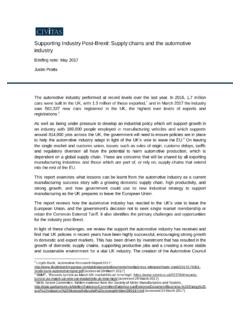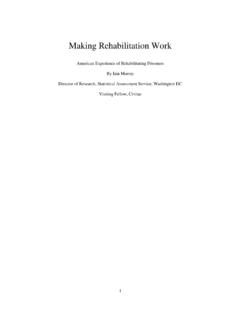Transcription of Justin Protts - Civitas
1 Closing the Finance GapHow a national investment bank could support enterprise and raise productivityJustin Prottsin association withClosing the Finance GapClosing the Finance GapHow a national investment bank could support enterprise and raise productivityJustin Prottsin association withivFirst Published February 2018 Civitas 201855 Tufton StreetLondon SW1P 3 QLemail: rights reservedISBN 978-1-906837-95-2 Independence: Civitas : Institute for the Study of Civil Society is a registered educational charity (No. 1085494) and a company limited by guarantee (No. 04023541). Civitas is financed from a variety of private sources to avoid over-reliance on any single or small group of the Institute s publications seek to further its objective of promoting the advancement of learning.
2 The views expressed are those of the authors, not of the byTypetechniquePrinted in Great Britain by4edge Limited, EssexvContentsAuthor viiSummary 11. The investment problem 82. How could a national investment bank help? 203. Designing an investment bank for the UK 40 Conclusion and proposals 49 Case Study I: The Industrial and Commercial 53 Finance CorporationCase Study II: Kreditanstalt f r Wiederaufbau 60 Case Study III: The Small Business Administration 73 Case Study IV: The European Investment Bank 80 Case Study V: The British Business Bank 88 Bibliography 97 Notes 99viviiAuthorJustin Protts is Chief Economist at Civitas , where he has worked since 2016.
3 His previous work includes supporting industry post - brexit : Supply chains and the automotive industry (2017), UK-EU trade and jobs linked to exports (2016) and Potential post - brexit tariff costs for EU-UK trade (2016). viii1 SummaryThe UK economy is suffering from low productivity and poor investment. This has weighed heavily on GDP growth since the 2008 financial crisis, with output per worker stagnating and productivity remaining among the lowest of any advanced productivity requires investment in productive enterprise. However, investment in the UK, as a proportion of domestic output, has fallen from about a quarter of GDP in 1990, when it was broadly in line with that of other developed economies, to just over 16 per cent.
4 It is now well below that of most advanced significant cause of this is that lending to business by banks, as a proportion of UK domestic lending, has declined from 31 per cent in 1988, to eight per cent in 2016. As the proportion of lending to business has decreased, lending to individuals and real estate lending neither of which are a type of investment which will help to boost long-term productivity have increased. Lending to business accounts for only five per cent of UK banking assets compared with 14 per cent of eurozone banking THE FINANCE GAP2 This means that despite the UK having the highest business start-up rate in Europe and world-leading research, it has performed badly when it comes to growing and developing businesses.
5 In the UK only three per cent of start-ups grow to over 10 employees over a three-year period, putting it among the worst performers in the is in part driven by the market failure described as the patient capital gap, or finance gap, which sees banks failing to invest in small and medium-sized enterprises (SMEs), even when there is demand from creditworthy businesses, due to access to easier returns from alternative investments. This has meant that, despite a recovery which has seen net lending to SMEs increase each quarter since the end of 2014, net lending to small- rather than medium- sized enterprises has continued to decline.
6 Even in 2015/16 some 19 per cent of SMEs seeking investments were unable to access suitable government has recognised the lack of financing and its impacts in its industrial strategy and has called for a review of what actions could be most effective in improving productivity and growth in SMEs . The Treasury has also been looking at how to increase the supply of capital available to help grow innovative firms, as part of its 2017 Patient Capital Review; the consultation paper for this notes that a lack of supply of appropriate capital appears to be one important factor that contributes to fewer firms scaling up.
7 3 SUMMARY The problems the UK faces now are not unique to our economy or our generation. Several countries, including the UK, have or have had institutions national development, promotional and investment banks and agencies which have been set up to address these issues. Such institutions have been mandated to provide finance directly or indirectly to SMEs to ensure that where markets have failed there is still investment in creditworthy SMEs. Though primarily owned by governments, these institutions are operationally independent and are either profitable or operate at a very low cost to the experiences of these institutions, which have been created with the express purpose of providing the long-term finance necessary for the growth and development of enterprise, provide potential lessons for the UK to draw on today.
8 The following six institutions are reviewed here:I. The Industrial and Commercial Finance Corporation (ICFC), a UK institution founded in 1945 but which no longer exists as it was created. The ICFC was initially effective at providing finance to grow British enterprises. It made profitable investments through a series of regional offices using local economic knowledge to gain a competitive advantage. However, having been initially set up with banks as shareholders, in an effort to avoid government involvement in financing business, the ICFC ownership model CLOSING THE FINANCE GAP4proved ineffective at ensuring the corporation continued to target the patient capital gap, then known as the Macmillan gap.
9 II. Germany s Kreditanstalt f r Wiederaufbau (KfW) is a government-owned promotional or development bank which in 2016 had a financing volume of 81 billion, of which billion of financing was for the promotion of SMEs, business founders and start-ups. KfW has provided financing for German enterprise for almost 60 years and has almost consistently returned a profit. It provides financing by on-lending through products offered by local banks across Germany. It is one of the safest banks in the world and has benefitted from a legally defined mandate and a federal government guarantee.
10 It is primarily funded through bond issues and so is able to raise funds without having to issues The US Small Business Administration (SBA) is an independent agency of the federal government. During the 2016 financial year, the SBA approved lending to small businesses of almost $29 billion. The SBA benefits from have a nationwide structure. However, it does not return a profit and has to seek funds from congress each year. This is likely because of two things. One, it is a government agency driven by policy objectives which are subject to political debate in the US Congress. Two, a proportion of financing is in the 5form of guarantees for national banks which have no ties to local The European Investment Bank (EIB) is a multilateral development bank.


















